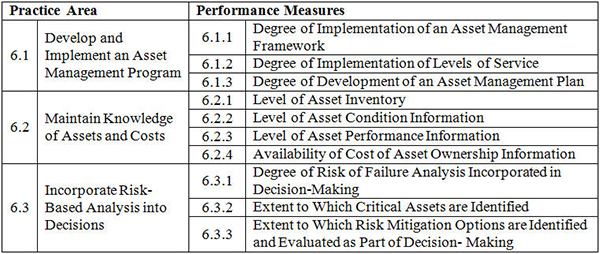From concept to reality: working the tool
The Albuquerque Bernalillo County Water Utility Authority in New Mexico provides water, wastewater, and reuse to the greater Albuquerque metropolitan area serving a population of about 630,000.
Managers launched an asset management initiative in 2007 to address the simultaneous challenges of aging infrastructure and the Great Recession. Four years later, they finished consolidating all water and wastewater assets and practices into a comprehensive strategy called the Asset Management Plan (AMP) they use to make and justify rehabilitation and replacement decisions.
In 2014, they began implementing a 10-year financial plan that includes several rate increases. This was a significant accomplishment, however the rest of the initiative stagnated. Many of the operational procedures and/or processes weren’t implemented.
Fortunately, their work on Performance Benchmarking for Effectively Managed Water Utilities provided a way to jump-start that part of the program.
Infrastructure Stability, which focuses on asset management, was one of three attributes the authority tested in 2011 when helping to develop the benchmarking tool. In 2014, managers decided to revisit this particular attribute, a practice the tool’s guidance documentation recommends. Using the three practice areas and 10 performance measures outlined in the table below, they assessed each of the authority’s five major asset groups.
When the self-assessment is complete, the free tool creates radar charts and provides a summary table of current and target scores, as well as the relative weights provided by the user during the model setup.
Figure 1 shows the relative impact and contribution each practice area had on the overall attribute total for the authority. Figure 2 shows the relative impact and contribution each performance measure had on the overall attribute total.
Albuquerque’s results revealed that each asset group was at a different stage of criticality. For example, a new surface water plant started operating in 2009, but the wastewater treatment plant built in 1962 needed significant rehabilitation.
Such information provided direction on where to focus attention, not just at the group level but utility-wide as well. For example, Maintain Knowledge of Assets and Costs, a practice area that addresses inventory, condition, performance, and cost information, needed to be tweaked to make the authority’s asset management initiative more effective.
Through a steering committee, managers developed nine recommendations for addressing performance gaps. One major goal is to better integrate their asset management and knowledge management strategies and to use this linkage to document service levels in a central location. The other eight:
- Update 2011 AMP.
- Update 2009 Knowledge Management Strategy.
- Better communication between CIP group and operation group.
- Make IBM Maximo Asset Management the core asset management database/inventory.
- Use Maximo to update condition status of parent assets (more up-to-date than AMP’s).
- Long-term goal to use Clevest Solutions Inc. to update inventory condition performance status.
- Upload labor rates from SunGard to Maximo to obtain accurate cost data.
- Develop/implement uniform risk ranking for Decade Plan.
Together, these will be beneficial for updating the AMP over the next two years and implementing operational changes based on best practices.
Mike Matichich, practice area lead for financial services at CH2M Hill (www.ch2m.com), Washington, D.C., was principal investigator for the WRF EUM benchmarking research project. E-mail michael.matichich@ch2m.com. Frank Roth, senior policy manager at Albuquerque Bernalillo Water Utility Authority (www.abcwua.org) in New Mexico, was the utility’s representative for the WRF EUM benchmarking project and continues to lead the utility’s use of related tools. E-mail froth@abcwua.org.
Next Page: 10 attributes of effectively managed water utilities



